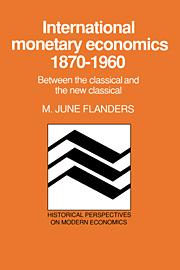Book contents
- Frontmatter
- Contents
- Preface
- 1 Preliminaries
- 2 Stream P
- 3 The beginnings of the neoclassical tradition
- 4 The locus classicus of the neoclassical position
- 5 The Macmillan Committee
- 6 A second diversion: Keynes and the Macmillan Committee
- 7 The anti-neoclassicals
- 8 Indian currency and finance: a tract on monetary reform
- 9 A treatise on money
- 10 Late Keynes: towards Bretton Woods
- 11 The crisis writers
- 3 Stream F
- 4 The confluence
- Ex post
- Bibliography
- Index
9 - A treatise on money
Published online by Cambridge University Press: 12 October 2009
- Frontmatter
- Contents
- Preface
- 1 Preliminaries
- 2 Stream P
- 3 The beginnings of the neoclassical tradition
- 4 The locus classicus of the neoclassical position
- 5 The Macmillan Committee
- 6 A second diversion: Keynes and the Macmillan Committee
- 7 The anti-neoclassicals
- 8 Indian currency and finance: a tract on monetary reform
- 9 A treatise on money
- 10 Late Keynes: towards Bretton Woods
- 11 The crisis writers
- 3 Stream F
- 4 The confluence
- Ex post
- Bibliography
- Index
Summary
The mechanism of adjustment
Keynes's view, as expressed in the Treatise, of the international adjustment mechanism under fixed exchange rates stems from the neoclassical preoccupation with the importance of the rate of interest and its impact on both the capital and current accounts. And it is Keynesian in its emphasis on the macroeconomic relationships. The inherited wisdom is difficult, he argues, to define and delineate.
No systematic treatment of the subject exists in the English language, so far as I am aware. You will search in vain the works of Marshall, Pigou, Taussig or Irving Fisher. Even Professor Cassel's treatment, which is somewhat fuller, does not examine the train of causation in any detail. Mr. Hawtrey has a little more to say; but he is somewhat unorthodox on this matter and cannot be quoted as an exponent of the accepted doctrine. There remains, however, one outstanding attempt at a systematic treatment, namely Knut Wicksell's Geldzins und Güterpreise, published in German in 1898, a book which deserves more fame and much more attention than it has received from English-speaking economists.
(Keynes 1930: Volume I, 186)I think his position can best be classified as a Wicksellian macroeconomic theory combined with a Marshall-Lerner type of analysis, involving real adjustments, relative price changes, elasticities, and non-traded goods.
- Type
- Chapter
- Information
- International Monetary Economics, 1870–1960Between the Classical and the New Classical, pp. 170 - 185Publisher: Cambridge University PressPrint publication year: 1990

